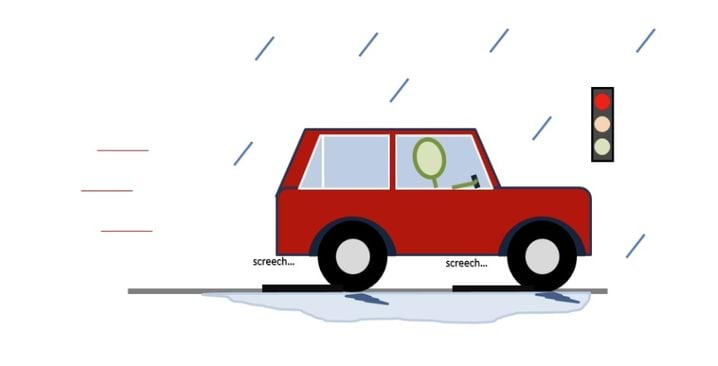Learning focus: | Friction is a force generated by an interaction between two surfaces, and which acts to resist movement between them. |
Observable learning outcome: | Explain how lubricants can reduce friction. |
Question type: | Diagnostic, two-tier multiple choice |
Key words: | Friction, lubrication, stopping distance |
Friction is the force generated by an interaction between two objects. This is different to most forces which cause the interaction (Hart, 2002).
A study of forty-seven secondary students, by Stead and Osborne (1981), showed that some students think that:
- friction depends on movement (seventeen students)
- friction only happens between solids (twelve students)
In Stead and Osborne’s 1980 study they found that half of 13-year old students also thought of friction as rubbing. But friction is also acting between objects that are not moving. Text books for 11-14 year old students often talk about shoes or tyres having a good grip. The implication is that the shoe or tyre ‘has a lot of friction’, which It does not. Rather it is good at generating friction when it is pushed along a surface, and often the friction it generates prevents it from moving.
In a study of 32 Canadian students aged 6-14, Erikson and Hobbs (1978) found that when thinking about two forces acting on the same object, students appeared to think of the forces as being engaged in a struggle, with the bigger force dominating the smaller one. This may lead some students to think that friction disappears when an object starts moving.
This question identifies those students who maintain these common misunderstandings about friction.
Students should complete the questions individually. This could be a pencil and paper exercise, or you could use an electronic ‘voting system’ or mini white boards and the PowerPoint presentation. The follow on question will give you insights into how they are thinking and highlight specific misunderstandings that some may hold.
If there is a range of answers, you may choose to respond through structured class discussion. Ask one student to explain why they gave the answer they did; ask another student to explain why they agree with them; ask another to explain why they disagree, and so on. This sort of discussion gives students the opportunity to explore their thinking and for you to really understand their learning needs.
Differentiation
You may choose to read the questions to the class, so that everyone can focus on the science. In some situations it may be more appropriate for a teaching assistant to read for one or two students. Expected answers
Water adds lubrication between the tyre and the road so that the surfaces are pushed slightly apart by the liquid. This means that when the brakes stop the wheels turning, the wheels slide more easily over the road surface and take longer to come to a stop. (In reality we brake less harshly so that the wheels do not slide over the surface – which would happen more easily in the wet.)
Some students who think that friction only acts between solids, are likely to give the answer a) C, b) C.
A few students may suggest answers a) A, b) A if they are thinking about pushing the water out of the way, which they may have experienced by running into the sea. It is unlikely that the amount of water here would have much effect.
An answer of a) B, b) D suggests that students are linking the property of friction to the tyres. They are in fact considering just one of the surfaces involved in an interaction between two surfaces. Friction is generated by the interaction between both surfaces.
If students have misunderstandings about how liquids (lubricants) can reduce, but not eliminate, friction, then it may help them to test the scientific explanation in a practical situation. This can also help those with a good understanding to consolidate their thinking. The following BEST ‘response activity’ could be used in follow-up to this diagnostic question:
- Response activity: Testing friction
Driver, R., Squires, A., Rushworth, P. and Wood-Robinson, V. (1994) Making sense of secondary science, research into children’s ideas, Routledge, London, England.
Hart, C. (2002), Teaching Newton’s laws as though the concepts are difficult, Australian Science Teachers' Journal, v48 n4 p14-23 Dec 2002.
Stead, K. E. and Osborne, R. J. (1980) Friction, LISP Working Paper 19, Science Education Research Unit, University of Waikato, Hamilton, New Zealand.
Stead, K. E. and Osborne, R. J. (1981) ‘What is friction: some children’s ideas’, New Zealand Science Teacher 27: 51-7.
